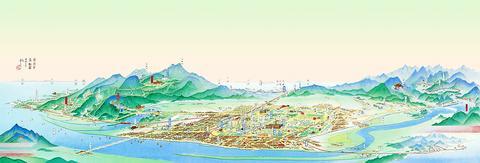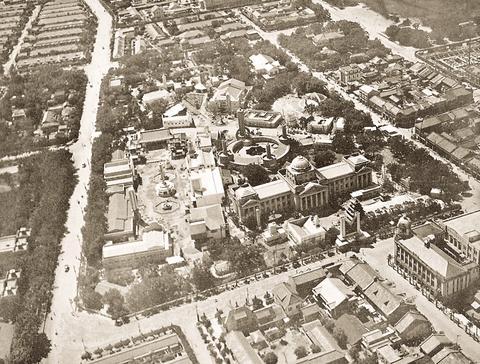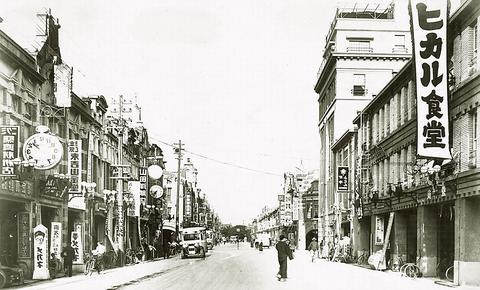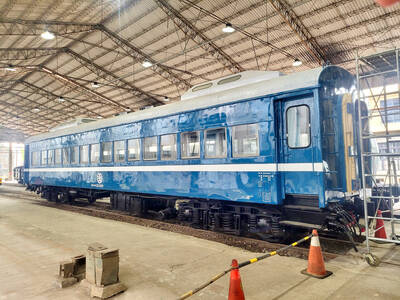Built atop an alluvial deposit-filled lake, Taipei City may not be one of the world's most picturesque metropolises and it might not be one of the oldest, but on Aug. 22, when the city celebrates its 120th birthday as the nation's economic and political nucleus, the city government hopes to remind Taipei residents that amid the urban sprawl lays a rich historical legacy.
Originally home to Taiwan's plains-living Aboriginal peoples, the basin that now cradles the nation's capital was first settled by ethnic Chinese from Fujian Province in the early 1700s. Records show that in 1709 a group of Fujian residents petitioned to Qing officials in a bid to open up land adjacent to the Tamsui River for development.

The first settlers arrived that same year and established settlements in and around what is today the Taipei suburb of Hsinchuang.

PHOTO COURTESY OF SMC PUBLISHING
By the mid-1800s, Wanhua, or Manka (
As the area's largest seaport, Dadaocheng and the surrounding area soon became Taipei's economic hub and prospered through trade in rice and teas. Quick to realize the benefits of amalgamating the trade zone with the numerous surrounding settlements for administrative purposes Qing officials established the municipality of Taipei Prefecture, or Taipei Fu (

The idea of relocating Taiwan's capital to Taipei first came into fruition in 1882, but it wasn't until Aug. 22, 1884, when Taiwan's first governor, Liu Ming-chuan (劉銘傳), relocated his offices to Taipei Fu and declared Taipei the new capital.
Liu created an administrative infrastructure that included the building of government offices and schools and commissioned the construction of a city wall.
Like many of the original Qing structures, the city wall was demolished for military and sanitary reasons in 1895 on the orders of Japan's first colonial governor, Motonori Kabayama. Over the next 40 years, Taipei was to lose much of its Qing tradition and was instead transformed into modern city with an up-to-date sewer system and countless engineering projects that saw Japanese architecture become the face of the new Taipei.
Successive decades of development have meant that many of the Qing structures that survived the Japanese have long disappeared and large numbers of Japanese colonial buildings have met with the wrecking ball and been replaced by modern edifices. The Taipei City Government's Cultural Affairs Bureau has attempted to stem the tide of what was, until as recently as four years ago, the widespread and unrestricted demolition of historical buildings.
"Until the late 1990s large numbers of old buildings were demolished by landowners illegally, but in the past three years the number has dropped significantly," said Wang Yi-chun (王逸群) of the city government's cultural bureau. "Landowners who demolish historical buildings now face a fine. And while the fine is a minimal NT$30,000, any landowner who demolishes such a building is now forbidden by law to build any other structure on the site."
While the bureau admits that not all of the city's old buildings can be saved, its policy has resulted in a huge increase in awareness regarding the need to protect the past.
"When the bureau was first tasked with the job of saving historical buildings, the picture was pretty grim. But with a full-time committee now working to preserve the sites, the number of buildings that are classified as heritage sites is at an all-time high," he said. "Public campaigns that promote the policy have meant that a lot more people are aware of the need to preserve the city's history."
Since the city government's culture bureau established its heritage-sites program and instituted a policy that restricted the demolition of historical sites, the number of protected structures throughout Taipei has risen to 120 and there are over 2,000 structures, that, while not protected by the law, are considered to have important historical significance.
"The criteria for what constitutes a heritage building is set by a committee that assesses buildings based on their cultural and historic values. Common buildings, such as the many Japanese colonial residences, are not considered as important as buildings with historical connections," said Wang.
"As long as they have historical significance, we put them on the list of protected buildings."
Some examples which show how much effort the city has put into the renovation and preservation of the city's historic buildings include the Chian Mu Residence (錢穆故居), Lin Yu-tang Residence (林語堂故居), the former residence of the American ambassador, or as it is now known, the Taipei Film House (台北之家) and the Yuanshan Villa, or the Taipei Story House, which sits adjacent the Taipei Fine Arts Museum.
The city government hopes that the series of events and exhibitions that are set to take place over the coming months in celebration of city's 120th anniversary can raise awareness of the need to preserve historic structures and prove to city residents that Taipei has a valuable history.
Current exhibitions related to the city's history include the Discovery Center of Taipei (
Up coming events include a partial renovation of the old city wall in September and a day-long festival and carnival in October.

Feb. 17 to Feb. 23 “Japanese city is bombed,” screamed the banner in bold capital letters spanning the front page of the US daily New Castle News on Feb. 24, 1938. This was big news across the globe, as Japan had not been bombarded since Western forces attacked Shimonoseki in 1864. “Numerous Japanese citizens were killed and injured today when eight Chinese planes bombed Taihoku, capital of Formosa, and other nearby cities in the first Chinese air raid anywhere in the Japanese empire,” the subhead clarified. The target was the Matsuyama Airfield (today’s Songshan Airport in Taipei), which

For decades, Taiwan Railway trains were built and serviced at the Taipei Railway Workshop, originally built on a flat piece of land far from the city center. As the city grew up around it, however, space became limited, flooding became more commonplace and the noise and air pollution from the workshop started to affect more and more people. Between 2011 and 2013, the workshop was moved to Taoyuan and the Taipei location was retired. Work on preserving this cultural asset began immediately and we now have a unique opportunity to see the birth of a museum. The Preparatory Office of National

China has begun recruiting for a planetary defense force after risk assessments determined that an asteroid could conceivably hit Earth in 2032. Job ads posted online by China’s State Administration of Science, Technology and Industry for National Defence (SASTIND) this week, sought young loyal graduates focused on aerospace engineering, international cooperation and asteroid detection. The recruitment drive comes amid increasing focus on an asteroid with a low — but growing — likelihood of hitting earth in seven years. The 2024 YR4 asteroid is at the top of the European and US space agencies’ risk lists, and last week analysts increased their probability

On Jan. 17, Beijing announced that it would allow residents of Shanghai and Fujian Province to visit Taiwan. The two sides are still working out the details. President William Lai (賴清德) has been promoting cross-strait tourism, perhaps to soften the People’s Republic of China’s (PRC) attitudes, perhaps as a sop to international and local opinion leaders. Likely the latter, since many observers understand that the twin drivers of cross-strait tourism — the belief that Chinese tourists will bring money into Taiwan, and the belief that tourism will create better relations — are both false. CHINESE TOURISM PIPE DREAM Back in July